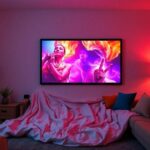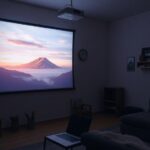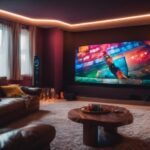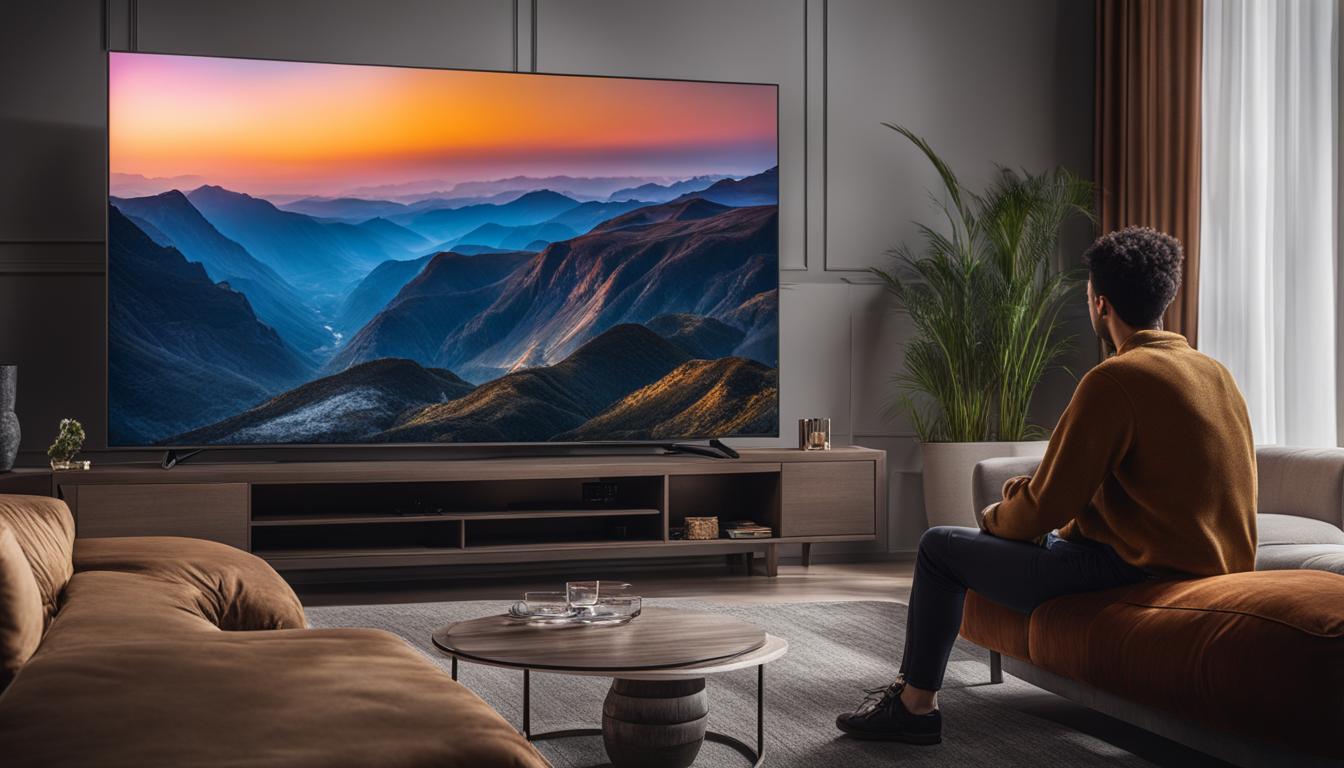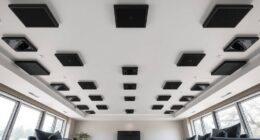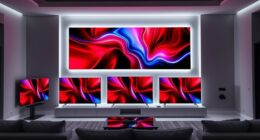The projection surface you choose has a significant impact on image quality, affecting brightness, contrast, and clarity. High-gain surfaces may boost brightness but can introduce issues like glare and mirroring. For true color representation, matte white screens are ideal, while grey surfaces enhance contrast in bright settings. The texture of the surface also matters; smoother finishes improve clarity, while rough textures scatter light unevenly. Front projection can struggle with ambient light, whereas rear projection minimizes this problem. Finding the right surface tailored to your projector can greatly enhance your viewing experience, and there's more to explore on optimizing your setup.
Key Takeaways
- Projection surfaces significantly influence image brightness, contrast, and clarity, impacting overall viewing quality.
- High-gain surfaces enhance brightness but may cause light flaring, while matte white screens ensure accurate color reproduction.
- Smooth textures improve clarity and detail, while rough or textured surfaces can scatter light, decreasing sharpness.
- Surface color affects brightness perception; grey screens improve contrast in bright environments by absorbing ambient light.
The Role of Projection Surfaces
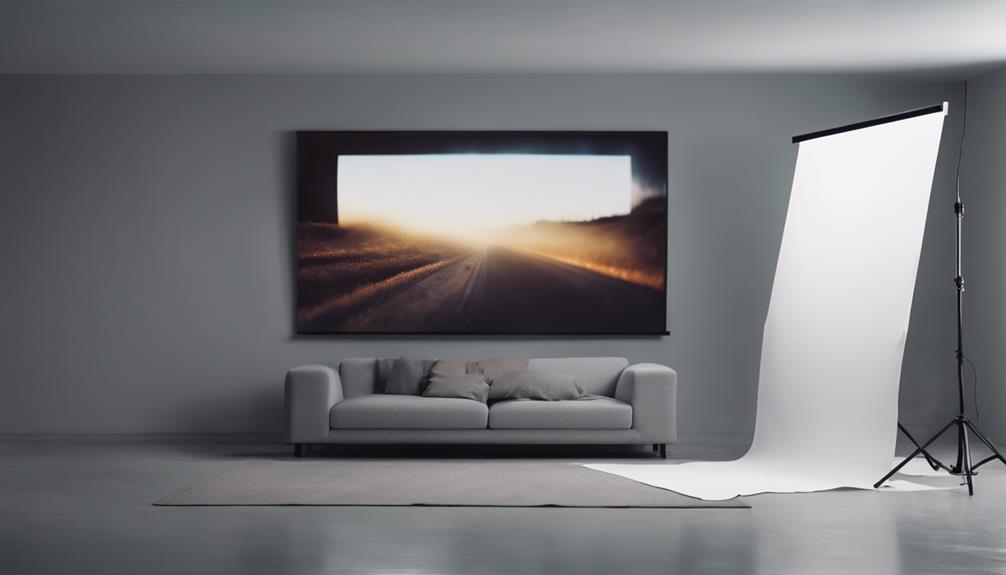
Projection surfaces greatly impact your image quality by influencing brightness, contrast, and clarity in projected visuals. Choosing the right projection surface isn't just a matter of preference; it's vital for achieving the best possible projected image. High-gain surfaces can enhance brightness, but they might also introduce issues like mirroring or light flaring, which can detract from the viewing experience.
The texture and material of your projection surface play significant roles in this equation. Whether you opt for a woven fabric or a smooth acrylic surface, each choice affects how light reflects and disperses, impacting the overall contrast ratio. For example, a matte white screen offers accurate color reproduction, while a grey surface can enhance contrast in well-lit environments.
Additionally, consider the viewing angles. Some surfaces perform better from various angles, guaranteeing that everyone in the room enjoys a clear, vibrant image.
It's essential to maintain proper flatness and tensioning of your projection surface to prevent distortion, especially on larger displays. By carefully selecting your projection surface, you can greatly enhance your image quality and guarantee an enjoyable viewing experience.
Surface Color and Brightness

The color of your projection surface directly affects how bright and vibrant the images appear, influencing your overall viewing experience. Surface color plays an essential role in brightness perception. For instance, matte white surfaces reflect light uniformly, providing ideal color accuracy.
In contrast, darker surfaces can enhance contrast in environments with ambient light, making them suitable for certain viewing conditions. If you're watching in a bright room, grey screens might be your best bet. They absorb some ambient light, improving perceived contrast without oversaturating colors.
On the other hand, silver screens are tailored to enhance brightness for 3D images but can compromise color fidelity and viewing angles due to their reflective properties. High-gain screens can boost brightness, yet they might create hot spots and restrict viewing angles, leading to uneven image quality for your audience.
Ultimately, the reflective properties and color of your projection surface are vital for achieving your desired projector image quality. The right choice allows you to maximize image quality, ensuring a more enjoyable viewing experience regardless of the environment.
Texture Impact on Clarity

Surface texture plays a key role in determining how clearly images are projected, as smoother finishes generally enhance light reflection and reduce distortion. When you choose a projection surface, consider how texture can impact image quality and clarity. Textured surfaces can scatter light unevenly, leading to decreased sharpness, especially with high-resolution content. For professional presentations, smooth surfaces are essential, as they improve readability and detail.
Here's a comparison of different surface textures and their impact on clarity:
| Surface Texture | Effect on Clarity |
|---|---|
| Smooth Surface | Enhances light reflection, minimal distortion |
| Matte Surface | Reduces glare, improves image quality |
| Semi-Matte Surface | Balances reflection and clarity |
| Textured Surface | Scatters light, may introduce moiré patterns |
| Rough Surface | Considerably decreases clarity |
Front Vs. Rear Projection

Choosing between front and rear projection can greatly influence your image quality and overall viewing experience. Each method has its own strengths and weaknesses depending on your environment and needs. Proper projector placement is vital to maximize the benefits of either setup, guaranteeing that you achieve the best possible results. Here are three key points to take into account:
- Ambient Light: Front projection is more susceptible to ambient light, which can diminish contrast and clarity. If you're in a well-lit room, rear projection may be the better choice since it reduces the impact of external light. For further enhancement of your home theater experience, think about using a <a target="_blank" rel="nofollow" href="https://1hometheatreprojector.com">sound system configuration</a> that suits your space.
- Surface Flatness: Both front and rear projection require a flat projection screen for ideal image quality. Any irregularities can distort the image, so using tensioned screens is vital to maintain clarity and precision.
- Space Requirements: Rear projection typically needs more depth for the projector setup, which may not be feasible in smaller spaces. Front projection, on the other hand, is generally easier to set up in tight areas.
Ultimately, your choice between front and rear projection should align with your specific application and the conditions of your viewing space to guarantee the best image quality possible.
Viewing Angles and Image Quality

Understanding how viewing angles impact image quality can help you make informed decisions about your projection setup, ensuring an ideal viewing experience for all audience members.
The viewing angle of your projection surface plays a significant role in determining how well your audience perceives the image. Wider viewing angles generally provide better visibility for larger groups but may come at the cost of brightness and contrast.
If you opt for high-gain screens, you'll enjoy enhanced brightness when viewed directly. However, these screens can narrow the best viewing angle, leading to washed-out colors and loss of detail when viewed from the sides.
On the other hand, matte surfaces offer wider viewing angles, maintaining consistent image quality across various viewer positions, although they may not be as bright as high-gain options.
It's essential to evaluate the best viewing angle, which usually falls between 30 to 45 degrees from the center. Beyond this range, you might notice a decline in image clarity and color fidelity.
To achieve the best results, align the characteristics of your projection surface with the intended viewing environment and audience size.
Selecting the Right Surface

How can you assure that your projection surface enhances image quality for your specific setup? Choosing the right screen surface is vital. Consider these factors:
- Screen Materials: Different materials, like woven fabric or acrylic, have distinct reflective properties. Matte white surfaces offer accurate color reproduction, while grey surfaces boost contrast in ambient light.
- Projector Brightness: Match the screen surface to your projector's brightness. High-gain screens reflect more light, which can enhance clarity but may narrow the viewing angle.
- Proper Tensioning: Confirm your screen is properly tensioned. Non-flat surfaces can distort images, affecting overall visual quality.
Also, think about the image size and how it interacts with your selected screen. A larger image may require a specific type of screen to maintain brightness and clarity.
Frequently Asked Questions
Does Projector Screen Affect Quality?
Yes, your projector screen affects quality considerably. The right surface enhances brightness and color accuracy, while the wrong one can distort images. Choosing an appropriate screen type guarantees you get the best viewing experience possible.
What Is the Best Surface for a Projector?
You might think any white wall works, but for the best projection, a matte white screen's your best bet. It guarantees vibrant colors and brightness, enhancing your viewing experience considerably without annoying glare.
How Much Difference Does a Projector Screen Make?
A projector screen makes a significant difference. You'll notice improved brightness, color accuracy, and contrast, enhancing your viewing experience. Choosing the right screen type can elevate your presentations or movie nights to a whole new level.
What Is the Quality of a Projector Image?
Did you know that a projector's brightness can drop by over 50% in ambient light? You'll find that image quality varies based on factors like brightness, contrast, and resolution, impacting your overall viewing experience considerably.
Conclusion
Choosing the right projection surface can make all the difference in your viewing experience.
You mightn't realize it, but the color and texture of the surface can enhance or diminish the clarity and vibrancy of your images.
Whether you're setting up for a movie night or a big presentation, remember that the surface you select can either elevate your visuals or leave them flat.
So, don't overlook this vital element—your audience will thank you for it!
Hello, I’m Art, and I’m excited to be a part of the 1Home Theatre Projector team. As a writer, I’m here to contribute my knowledge and insights to help you achieve the ultimate home cinema experience. I understand that making decisions in the world of home entertainment can be complex, and I’m here to simplify the process for you.




